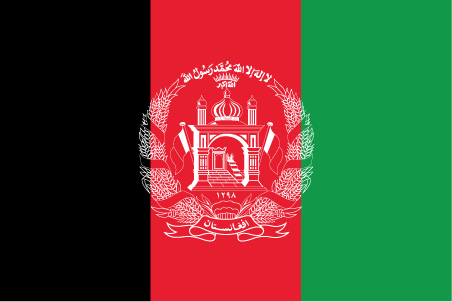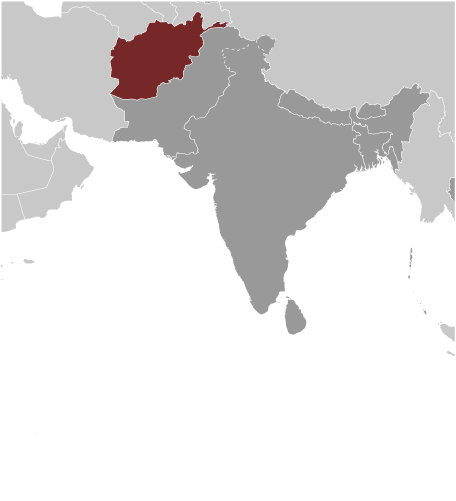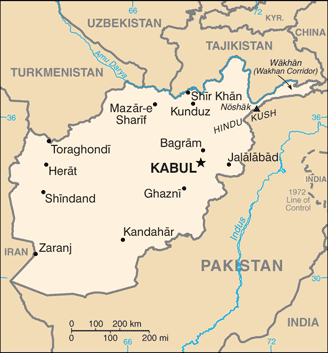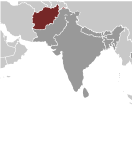
|
|
Advertisements:
People And SocietyNationality
Noun Afghan(s)
Adjective Afghan Ethnic groups
Pashtun 42%, Tajik 27%, Hazara 9%, Uzbek 9%, Aimak 4%, Turkmen 3%, Baloch 2%, other 4% Languages
Afghan Persian or Dari (official) 50%, Pashto (official) 35%, Turkic languages (primarily Uzbek and Turkmen) 11%, 30 minor languages (primarily Balochi and Pashai) 4%, much bilingualism, but Dari functions as the lingua franca Note The Turkic languages Uzbek and Turkmen, as well as Balochi, Pashai, Nuristani, and Pamiri are the third official languages in areas where the majority speaks them Religions
Sunni Muslim 80%, Shia Muslim 19%, other 1% Population World Ranking: 40
30,419,928 (July 2012 est.)
Note This is a significantly revised figure; the previous estimate of 33,609,937 was extrapolated from the last Afghan census held in 1979, which was never completed because of the Soviet invasion Age structure
0-14 years
42.3% (male 6,464,070/female 6,149,468) 15-64 years 55.3% (male 8,460,486/female 8,031,968) 65 years and over 2.4% (male 349,349/female 380,051) (2011 est.) Median age
Total 17.9 years
Male 17.8 years Female 17.9 years (2012 est.) Population growth rate World Ranking: 39
2.22% (2012 est.)
Birth rate World Ranking: 13
39.3 births/1,000 population (2012 est.) Death rate World Ranking: 8
14.59 deaths/1,000 population (July 2012 est.) Net migration rate World Ranking: 170
-2.51 migrant(s)/1,000 population (2012 est.) Urbanization
Urban population 23% of total population (2010)
Rate of urbanization 4.7% annual rate of change (2010-15 est.) Major cities - population
KABUL (capital) 3.573 million (2009) Sex ratio
At birth 1.05 male(s)/female
Under 15 years 1.03 male(s)/female 15-64 years 1.04 male(s)/female 65 years and over 0.87 male(s)/female Total population 1.03 male(s)/female (2011 est.) Maternal mortality rate World Ranking: 21
460 deaths/100,000 live births (2010) Infant mortality rate World Ranking: 1
Total
121.63 deaths/1,000 live births Male 129.51 deaths/1,000 live births Female 113.36 deaths/1,000 live births (2012 est.) Life expectancy at birth World Ranking: 217
Total population 49.72 years
Male 48.45 years Female 51.05 years (2012 est.) Total fertility rate World Ranking: 8
5.64 children born/woman (2012 est.) Health expenditures World Ranking: 66
7.4% of GDP (2009)
Physicians density
0.21 physicians/1,000 population (2009) Hospital bed density
0.4 beds/1,000 population (2009) Drinking water source
Improved
Urban: 78% of population Rural: 39% of population Total: 48% of population Unimproved Urban: 22% of population Rural: 61% of population Total: 52% of population (2008) Sanitation facility access
Improved
Urban: 60% of population Rural: 30% of population Total: 37% of population Unimproved Urban: 40% of population Rural: 70% of population Total: 63% of population Hiv/aids - adult prevalence rate World Ranking: 165
0.01% (2001 est.)
Hiv/aids - people living with hiv/aids
NA
Hiv/aids - deaths
NA
Major infectious diseases
Degree of risk High
Food or waterborne diseases Bacterial and protozoal diarrhea, hepatitis A, and typhoid fever Vectorborne disease MalariaAnimal contact disease Rabies Note Highly pathogenic H5N1 avian influenza has been identified in this country; it poses a negligible risk with extremely rare cases possible among US citizens who have close contact with birds (2009) Children under the age of 5 years underweight World Ranking: 13
32.9% (2004)
Education expenditures
NA
Literacy
Definition
Age 15 and over can read and write Total population 28.1%Male 43.1% Female 12.6% (2000 est.) School life expectancy (primary to tertiary education)
Total 9 years
Male 11 years Female 7 years (2009)
Comments
Add a new comment: |
Advertisement
Members area
Afghanistan (Kabul):
 
GPS points from Afghanistan (Kabul)
|
||||||||

 Ahmad Shah DURRANI unified the Pashtun tribes and founded Afghanistan in 1747. The country served as a buffer between the British and Russian Empires until it won independence from notional British control in 1919. A brief experiment in democracy ended in a 1973 coup and a 1978 Communist counter-coup. The Soviet Union invaded in 1979 to support the tottering Afghan Communist regime, touching off a long and destructive war. The USSR withdrew in 1989 under relentless pressure by internationally supported anti-Communist mujahedin rebels. A series of subsequent civil wars saw Kabul finally fall in 1996 to the Taliban, a hardline Pakistani-sponsored movement that emerged in 1994 to end the country's civil war and anarchy. Following the 11 September 2001 terrorist attacks in New York City and Washington, D.C., a US, Allied, and anti-Taliban Northern Alliance military action toppled the Taliban for sheltering Osama BIN LADIN. The UN-sponsored Bonn Conference in 2001 established a process for political reconstruction that included the adoption of a new constitution, a presidential election in 2004, and National Assembly elections in 2005. In December 2004, Hamid KARZAI became the first democratically elected president of Afghanistan and the National Assembly was inaugurated the following December. KARZAI was re-elected in August 2009 for a second term. Despite gains toward building a stable central government, a resurgent Taliban and continuing provincial instability - particularly in the south and the east - remain serious challenges for the Afghan Government. In January 2011, Afghanistan assumed a nonpermanent seat on the UN Security Council for the 2012-13 term.
Ahmad Shah DURRANI unified the Pashtun tribes and founded Afghanistan in 1747. The country served as a buffer between the British and Russian Empires until it won independence from notional British control in 1919. A brief experiment in democracy ended in a 1973 coup and a 1978 Communist counter-coup. The Soviet Union invaded in 1979 to support the tottering Afghan Communist regime, touching off a long and destructive war. The USSR withdrew in 1989 under relentless pressure by internationally supported anti-Communist mujahedin rebels. A series of subsequent civil wars saw Kabul finally fall in 1996 to the Taliban, a hardline Pakistani-sponsored movement that emerged in 1994 to end the country's civil war and anarchy. Following the 11 September 2001 terrorist attacks in New York City and Washington, D.C., a US, Allied, and anti-Taliban Northern Alliance military action toppled the Taliban for sheltering Osama BIN LADIN. The UN-sponsored Bonn Conference in 2001 established a process for political reconstruction that included the adoption of a new constitution, a presidential election in 2004, and National Assembly elections in 2005. In December 2004, Hamid KARZAI became the first democratically elected president of Afghanistan and the National Assembly was inaugurated the following December. KARZAI was re-elected in August 2009 for a second term. Despite gains toward building a stable central government, a resurgent Taliban and continuing provincial instability - particularly in the south and the east - remain serious challenges for the Afghan Government. In January 2011, Afghanistan assumed a nonpermanent seat on the UN Security Council for the 2012-13 term.